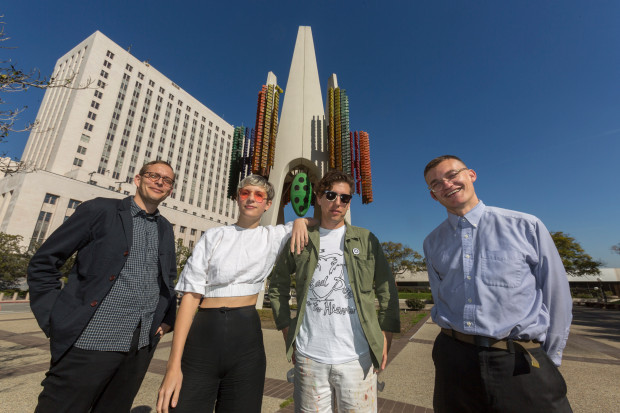For 40 years, Joseph Young festooned public buildings, open spaces and private places across his adopted city of Los Angeles with dozens of brilliant, colorful mosaics, larger-than-life murals and towering sculptures.
But the work the artist hoped he would be best remembered for was the Triforium. And he was, but for all the wrong reasons.

From left: Tanner Blackman, Claire Evans, Jona Bechtolt and Tom Carroll, members of the Triforium project, pose with Joseph L. Young’s Triforium, a “polyphonoptic” public sculpture, at the Fletcher Bowron Square in downtown Los Angeles on Feb. 1. (AP-Yonhap)
The space-age-looking pointy edifice that stands six stories tall and is covered with 1,494 colorful lights that once blinked in time to music blasted from its four gigantic speakers was mocked from the day it made its feedback-ridden, embarrassingly screechy 1975 debut.
Critics gave it nicknames like The Trifoolery, The Schlockenspiel and The Million-Dollar Jukebox, and those were the nicer ones. Network news correspondents implied the people of Los Angeles were fools to shell out nearly a million bucks to build this silly thing.
“The Triforium will be a different kind of a landmark. It will be the landmark that people will come to and say, ‘What the hell is this?’” Zev Yaroslavsky, then a city councilman, told The CBS Evening News.
But that’s because Young’s vision was about a half-century ahead of its time, Tom Carroll, host of the popular local web show “Tom Explores Los Angeles,” told the Associated Press as he stood under the structure last week.
It was around the time of Triforium’s 40th birthday that Carroll and three friends decided Young’s creation -- sitting silent for years and with about two-thirds of its lights burned out -- should not only be restored but resurrected in a way that would celebrate the artist’s original vision.
Young had, after all, wanted it to eventually contain lasers ricocheting light off surrounding buildings as ground sensors triggered music created by passers-by, said his daughter Cecily Young.
Almost no one took Carroll and his friends’ 2015 vision any more seriously than they had Young’s 1975 one until two months ago. That was when a foundation that annually hands out $1 million in innovation grants gave them one for $100,000.
“Joseph Young’s vision for the sculpture was imaginative, pairing technology and arts in a way that was well before its time,” Goldhirsch Foundation President Tara Roth said when the award was announced. “Triforium Project is going to help Los Angeles breathe new life into a piece of our cultural history.”
Not that it will be easy.
The work’s sounds were originally provided by a musician playing a huge, custom-built steel carillon hidden in an underground mall beneath the structure. The instrument was sold long ago and the musician replaced by a CD player. Then the speakers broke, most of the lights died, and the refrigerator-sized 1970s-era computers that ran the whole thing became obsolete.
Eventually everyone forgot how to turn on the lights until a 40th anniversary gathering when someone asked, “What does this switch do?”
“What we want to do is replace the computer system entirely with something that is network simple, easy to update, open-sourced and remotely accessible so that we can turn the instrument into something genuinely interactive for residents of the 21st century,” said musician Claire Evans, who along with Carroll, urban planner Tanner Blackman and Jona Bechtolt, her bandmate in the pop-dance group Yacht, co-founded the Triforium Project.
Before that happens they’ll need approvals from various city agencies, including the Cultural Affairs Department, which owns The Triforium. Department officials didn’t respond to phone or email messages this week, but Evans says her group is working with them.
Joseph Young, who died in 2007, created several popular public works throughout the city. “Topographic Map,” a mosaic of Los Angeles County‘s water system, complete with a waterfall and reflecting pool, graces one side of downtown’s county Hall of Records building. Other works include the powerful Holocaust Monument in the city‘s Pan-Pacific Park and a colorful bas relief portal depicting the 12 tribes of Israel at Eden Memorial Cemetery, where Young is buried.
“My father absolutely wanted to make an impact on urban life, and he wanted it to be transformative and be something that would trigger interactions between people,” said Cecily Young. She added she and her sister Leslie Young are thrilled a new generation has discovered Triforium.
Even Yaroslavsky, retired from local politics after nearly 40 years and now a director at UCLA’s Luskin School of Public Affairs, has mellowed some. He says it was mainly the work‘s high price, paid for with taxpayer dollars, that set him off.
“But you know what? With all that’s going on in the country right now, the Triforium is the least of my concerns. And as long as no public money is spent on it, I don’t give a damn,” he said with a laugh. (AP)






![[KH Explains] Hyundai's full hybrid edge to pay off amid slow transition to pure EVs](http://res.heraldm.com/phpwas/restmb_idxmake.php?idx=645&simg=/content/image/2024/04/18/20240418050645_0.jpg&u=20240419100350)